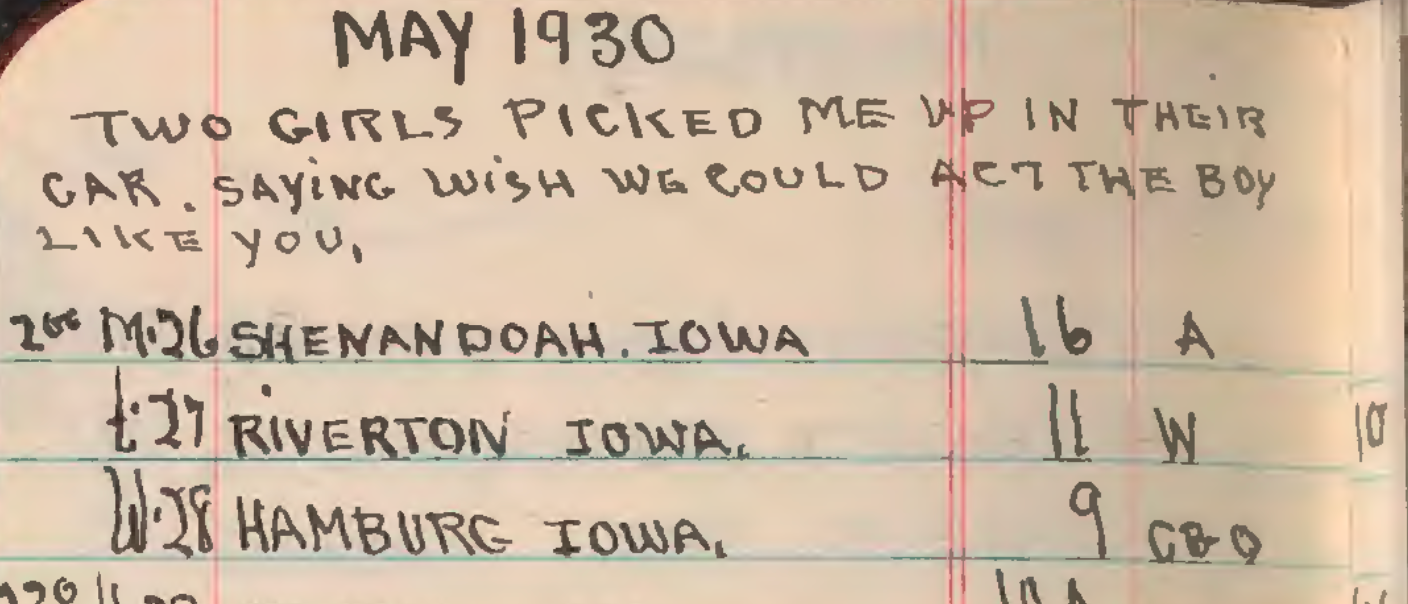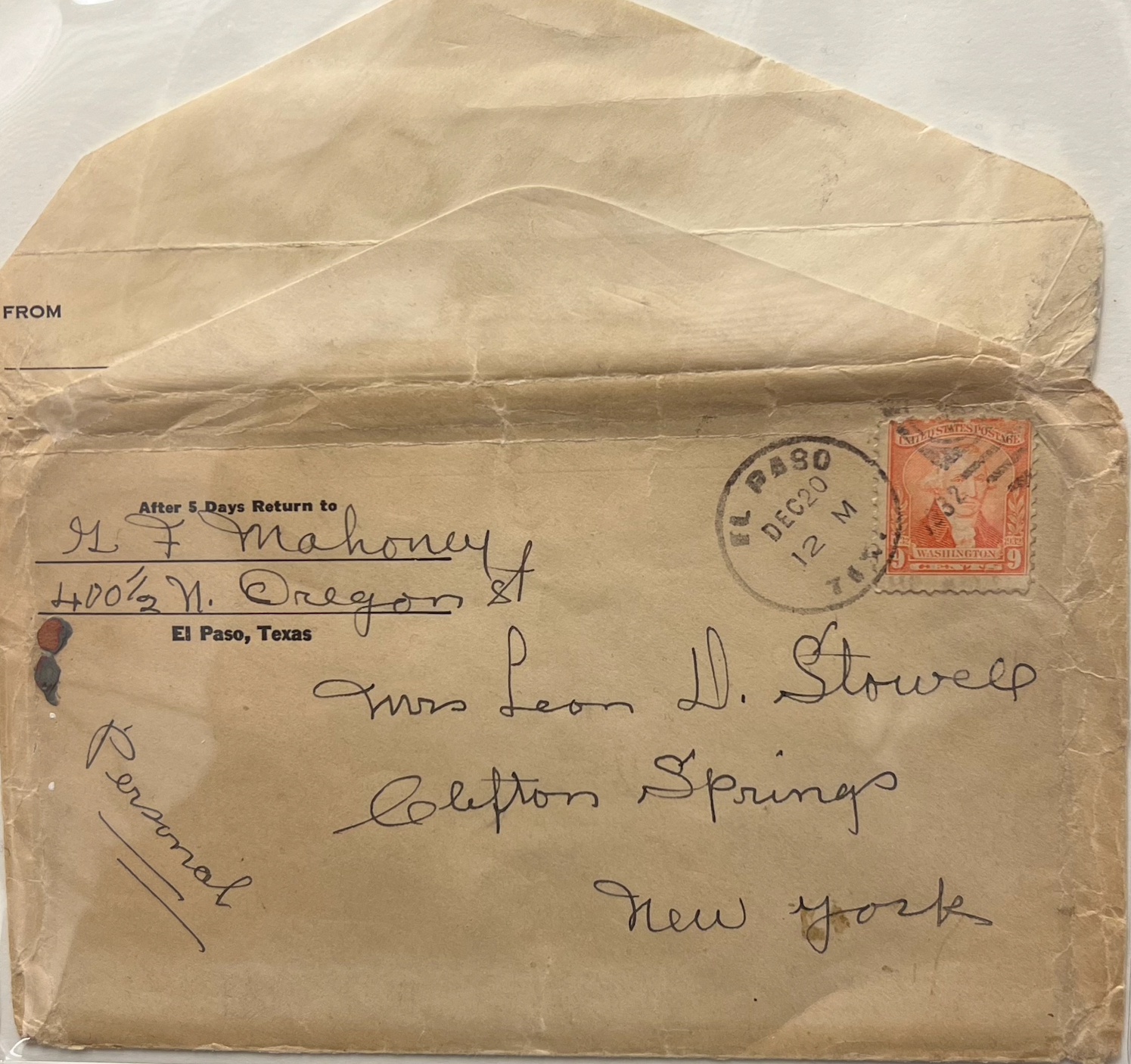By Nidhi Gundimeda
Geo F. Mahoney’s journal from 1930-1932 reveals the experiences of an androgynous person traveling through the American west, offering us a glimpse of the relationship between gender identity and American history and culture. Mahoney, born on February 3, 1878, traveled from January 1, 1930 – December 31, 1932. Their journal entries documented financial and informational logs, personal anecdotes, travel information, and a letter for Mrs. Leon D. Stowell. Mahoney documented the names of cities and towns they visited, the number of miles they traveled, and the abbreviated names of railroad lines. They traveled approximately 35,000 miles around eighteen states in the western United States through various forms of transportation, including bus, boxcar, and train. In December 1932, Mahoney lived in El Paso, Texas. This is one of the only long-term locations recorded during their travel period, approximately when Mrs. Stowell received the correspondence. Also known by her maiden name, Oma M. Travis (1912-2002), she cordially corresponded with Mahoney, indicating a prior friendship between the two. Furthermore, the letter entails condolences for the death of Annie Johnson Flint and others’ confusion over Mahoney’s gender. Additionally, some entries include brief notes about Mahoney’s experiences. Some of Mahoney’s main entries include their experiences with poverty, struggling for shelter, and their experience with gender identity while traveling.

Throughout our time at the Clements Library, various topics, including gender, class, and sexuality, were actively discussed as a way to give a new voice to trailblazers of past generations. Jen Manion tells us about “female husbands,” the 18th-century term for a person assigned female at birth, living as a man, who marries a woman. While discussing the history of “female husbands,” much of our conversation discussed the defiance of basic and limiting categorization of sexuality and gender. Furthermore, this concept stretches to individual autonomy– one’s right to choose their identity. While viewing Geo F. Mahoney’s journal through this lens, there are great similarities in their unrestricted view of gender expression. For example, in Mahoney’s journal, they state that “The funny Part is People Dont Know if I am a HE OR- A SHE.” Such entries depict the powerful, androgynous identity belonging to Geo F. Mahoney, allowing them the autonomy to choose who they are. In Geo’s case, they have the autonomy to also refuse categorization. Overall, the social construct of gender supports how Mahoney expresses their gender amongst others in various periods.

In addition, further analysis of Mahoney’s journal and experiences can be performed utilizing external research related to gender and sexuality. Historian Peter Boag argues that the U.S. West was a space of gender exploration, and with the frontier’s closure came increasingly strict and rigid interpretations of gender roles. Boag’s book provides an elementary foundation for gender and sexual identification, as he makes an argument that the enforcement of heterosexuality and the gender binary was solidified before the Western frontier closed. When analyzing Mahoney’s experiences, however, we see that people had continued to use the U.S. West as a space for gender exploration and identity creation. Even after the turn of the 20th century (Boag’s claim), a source like Geo’s journal disrupts the idea of gender identity as we know it, constantly reinventing it to the present day. Additionally, he cites cross-dressing as a mechanism of expression, allowing westerners to redefine their identity through clothing. Boag further writes that cross-dressing accepted men and women to participate, as well as people of many cultures. Similarly, Mahoney also utilized cross-dressing and clothing ambiguity during their time traveling. However, it remains unclear whether Mahoney cross-dressed as a means of obscuring identity for safety, amusement, or for other reasons. Boag’s historical insight into the century before Mahoney’s travels reveals more of the relationship between gender identity and American history and culture.

Mahoney’s journal is a testament to gender identity and expression throughout American history. Through their journal, readers understand what struggles Mahoney experienced regarding class and socioeconomic struggles, as well as those of gender identity and expression. Furthermore, Geo F. Mahoney’s journal is significant to the overall American identity seen through a gender-specific lens because it is a first-hand account of self-identity and other peoples’ responses in written documentation. In addition, this journal provides evidence that gender non-conforming people questioned gendered norms and sought ways to comprehend their inner experiences long before the creation of terms like “gender neutral,” “non-binary,” and “androgynous.” The experiences of Mahoney through this journal highlight the power of self-expression and the desire to find oneself through various mechanisms including clothing, speech, and other cultural forms. Sources such as Mahoney’s journal allow readers to dissect relations of minority groups in such prevalent times in the United States, allowing us to listen to and spread the stories of underrepresented voices in America’s past.

Geo. F. Mahoney Journal, William L. Clements Library, The University of Michigan
Manion, Jen. Female Husbands: A Trans History. Cambridge University Press, 2020.
Boag, Peter. Re-Dressing America’s Frontier Past. 1st ed., University of California Press, 2011. JSTOR, http://www.jstor.org/stable/10.1525/j.ctt1pnk86. Accessed 3 Dec. 2022.
